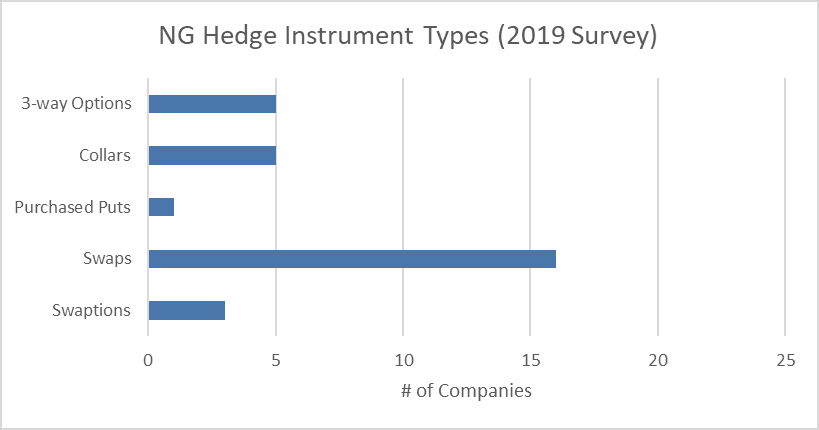Hedging remains a mainstay activity for many oil and gas producers, and some crude producers are hedging their crude production farther out into the future than they have in recent history.
Price volatility in oil and gas markets remain an enduring fact of the energy industry. Spot prices for NYMEX WTI futures plummeted in early 2020 mostly due to the uncertainty around the coronavirus outbreak. NYMEX WTI futures even traded at negative prices for a brief period in April 2020, but prices ticked upward and hovered in the $40/bbl range for most of the last half of 2020. Natural gas price remained depressed from 2019, and the spot price of natural gas remained below $2/MMBtu for most of early 2020. However, prices for natural gas did trend upward during the last quarter of 2020.
The following is a survey of the 30 largest public oil and gas exploration and production (E&P) companies and their hedging activities as disclosed in their December 31, 2020 10-K filings. It also includes comparisons to the same survey done in the prior year.
The following survey provides as much information as possible based on what was disclosed in regulatory filings. U.S. GAAP accounting rules form the minimum disclosures companies must provide in their filings to provide users with an understanding of:
- An entity’s use of hedges
- How the hedges and the hedged production are accounted for in the filing
- How the hedges affect the financial statements.
While the accounting rules require entities to disclose the level of an entity’s derivative activity, there can be variance in practice as to how much information a company discloses about the instrument types, volume of production hedged and the average hedge price.
Why Hedge?


Upstream companies have relatively straightforward objectives, which are to search for, develop and extract hydrocarbons. These activities are very capital intensive and require large amounts of cash. Companies need enough cash flow, not only to support a level of capital expenditures and exploration activity to ensure that oil and gas continues to flow, but also to make debt payments, comply with debt covenants and support the general and administrative costs. Hedging programs at upstream oil and gas companies are developed with the primary purpose of providing a level of cash flow to increase the likelihood of meeting those needs.
Without the protection of an effective hedging program, an upstream oil and gas company’s cash flows are subject to the volatility of the market. An upstream oil and gas company without hedges will benefit from higher market prices, but they have a very short amount of time to react when market prices decline.
The following outlines the percentage of companies in the survey that maintained hedges as of December 31, 2020 for crude, natural gas, or natural gas liquids (NGLs). Consistent with prior years, most public oil and gas producers maintain hedging programs.
Companies That Had Hedges
Twenty-seven of the 30 upstream energy companies surveyed, or 90%, had hedges on the books on December 31, 2020. This is up from 83% on December 31, 2019, and more consistent with prior year survey results. At the end of 2020, 73% of the surveyed companies had crude hedges in place and 73% had gas hedges in place.






Instrument Types
Investors should carefully consider the types of instruments utilized. Not all hedging strategies are created equal and provide different levels of downside protection. The following notes the number of companies holding various instrument types in their hedging portfolio.
For a producer, swaps provide the highest amount of downside protection. However, swaps limit upside price participation. This leads producers to utilize purchased puts, which can be costly, or costless collars, which allow the producer to participate within a range of price movements. Other instruments noted in the survey were swaptions and three-way options. Swaptions, often used to raise a strike price by allowing a counterparty to increase the volume or lengthen the tenor of the contract at their discretion, continue to represent a minority of the instrument types utilized by the public companies.
Of the public oil and gas companies reviewed, swaps continue to be the preferred instrument for both natural gas and crude. A strategy utilizing both swaps and collars was common for both crude and natural gas. The types of instruments used for gas remained generally consistent with the prior year. However, there was a notable increase in the number of companies with natural gas collars.


Length Of Hedging
When executing a hedging program, many companies are challenged with how far out to hedge their production. If the prices increase over time, they largely give up the upside. However, if the prices drop, it allows the company to weather the storm for a longer period. Based on the survey results, it is common for companies to hedge some level of the prompt 12-month period representing 2021. A handful of companies hedged crude in 2023 and 2024. This is much longer than prior year surveys where most companies would only have hedges in prompt two years of crude production. The length of hedging for natural gas has largely remained consistent over the years where most companies hedge the first 24 months and some companies hedged out to 2025.
Price Levels
As a hedging program is intended to increase cash flow predictability, the price level at which companies execute hedges is often heavily influenced by operating budgets and debt compliance.
Of the 27 companies that disclosed that they had hedges on their books at the end of 2020, 24 gave their average floor prices for WTI Cushing crude, Henry Hub natural gas, or both. The average swap price for crude was $44.69/bbl for 2021 and $43.88/bbl for 2022 and natural gas was $2.69/MMBtu for 2021 and $2.58/MMBtu for 2022. The average put price (non-three way) for crude was $39.25/bbl for 2021 and $38.69/bbl for 2022 and natural gas was $2.54/MMBtu for 2021 and $2.50/MMBtu for 2022.
Hedge Coverage
Consistent with the prior year survey, few companies disclosed the amount of their forecasted production that was hedged as of December 31, 2020. Only four companies disclosed a percentage of forecasted production hedged. For the companies that did disclose this information, the average hedge level for crude was 80% of forecasted 2021 production and, for natural gas, was 79% of forecasted 2021 production. Note that these hedge levels include coverage provided by three-way options.
In summary, the implementation of an effective hedging program can be a tool that helps ensure certainty of cash flow and provide a longer reaction time in the event of a market price collapse. Management teams are encouraged to consider the various hedging alternatives and strategies available to them. Opportune LLP is the premier hedge execution advisory and financial advisory firm for the upstream oil and gas sector. Our professionals offer the unique understanding of the hedging and operational processes that allow us to present alternatives that meet the needs of upstream oil and gas companies during these volatile times.
As a Managing Director at Opportune, Shane assists companies and financial institutions throughout North America, South America, Europe and Asia-Pacific in their understanding of what is possible as they deal with the challenges of implementing risk management programs and highly technical accounting pronouncements. Shane oversees the risk management, derivatives, stock-based compensation and complex securities service offerings of Opportune. He assists clients with the entire risk management life cycle, including strategy, execution, compliance, valuation and hedge accounting. He has undergraduate and graduate degrees in accounting from Oklahoma State University. He is also a member of the American Institute of Certified Public Accountants.
Josh Schulte is a Manager in Opportune’s Commodity Risk Management Advisory group. He assists companies with developing and executing complex risk management programs. Josh has a B.S. in Mathematics from the University of Texas at Austin and has a Series 3 Securities License.
Jeff Nicholson is a Senior Consultant in Opportune LLP’s Derivative Reporting Practice. He assists companies with the reporting and analysis of derivatives and complex securities. Jeff has a B.S. in Business Administration and Management and M.S. in Finance from the University of Colorado.
Oil and gas operations are commonly found in remote locations far from company headquarters. Now, it's possible to monitor pump operations, collate and analyze seismic data, and track employees around the world from almost anywhere. Whether employees are in the office or in the field, the internet and related applications enable a greater multidirectional flow of information – and control – than ever before.










